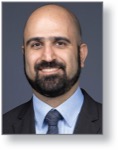Krystyna Houser had just had her third child when she started feeling depressed, with bloating and gastrointestinal discomfort. Over the next two years, she visited numerous doctors who wrote off her symptoms as postpartum depression. The trajectory of her illness changed when she connected with a medical team at Cedars-Sinai, in Los Angeles, who diagnosed her with small intestinal bacterial overgrowth. She was treated with an elemental diet and fully recovered, but the downside of the process was a big one: an unpleasant taste.
“Traditional elemental diets are notoriously unpalatable,” said Ali Rezaie, MD, the medical director of the GI Motility Program at Cedars-Sinai, who along with Mark Pimentel, MD, the executive director of Cedars-Sinai’s Medically Associated Science and Technology Program, led Ms. Houser’s care team. “They taste sulphury—like drinking hot spring water straight from the source.”
Braden Kuo, MD, MSc, a gastroenterologist and neurogastroenterologist at Massachusetts General Hospital, in Boston, told Gastroenterology &. Endoscopy News that he typically only recommends the elemental diet to patients with short bowel syndrome (SBS) and only through a feeding tube directly into the small intestine to bypass the taste. “I can’t even think in my mind of any patient that could tolerate the elemental diet formulation by mouth,” Dr. Kuo said. “It’s almost universally delivered by tube due to palatability.”
The taste of elemental diets is so unpleasant that, in 2024, a comprehensive review of the diet found that historical clinical trials examining its efficacy had a dropout rate of about 40% (Dig Dis Sci 2024;69[9]:3344-3360).
Beyond the unfortunate taste, elemental diets have historically been prohibitively expensive and are not always covered by insurance. Dr. Rezaie estimated that an elemental diet course to feed an average adult usually carries an out-of-pocket cost of $600 per week for brands such as NestlÉ’s Vivonex Plus.
But both of those major hurdles—cost and palatability—may be addressed by a new product (mBIOTA Elemental, mBIOTA Labs) that Ms. Houser and Dr. Rezaie teamed up to launch with other GI advocates and physicians.
In a study published in Clinical Gastroenterology and Hepatology (2025 Apr 4. doi.org/10.1016/j.cgh.2025.03.002). Dr. Rezaie and his co-investigators, including Dr. Pimentel and Ms. Houser, found that all 30 patients studied could tolerate the new product exclusively for two weeks with a 100% adherence rate.
The study included adults with positive lactulose breath tests (LBTs) for small intestinal bacterial overgrowth (SIBO) and/or intestinal methanogen overgrowth (IMO) who completed one week of screening, two weeks of the elemental diet and two weeks of follow-up with reintroduction of a regular diet. The primary end point was changes in stool microbiome after the elemental diet and reintroduction of a regular diet. Secondary end points included tolerability, the rate of normalization of LBTs, symptomatic response and adverse events. Approximately 20% of the patients had SIBO, 40% had IMO and 40% had a combination of the two.
After the elemental diet, the investigators saw significant changes in the relative abundance of various microbial species, the most significant being decreases in the relative abundance of Prevotella 9 and Fusobacterium. In addition, the abundance of Methanobrevibacter smithii decreased at the end of the trial and correlated with average daily methane levels (P=0.024; r=0.489). Maximum levels of methane (41±35 to 12±15 ppm; P<0.001) and hydrogen (43±42 to 12±11 ppm; P<0.001) decreased significantly, with 73% of the patients normalizing their LBTs.
During the second week of the elemental diet, patients showed significant improvement in weekly average severity of several symptoms: abdominal discomfort (P=0.02), bloating (P<0.001), constipation (P=0.04), distension (P<0.001) and flatulence (P<0.001). Diarrhea severity increased along with stool image artificial intelligence analysis (P=0.001). No significant change was observed for abdominal pain (P=0.38), belching (P=0.80), brain fog (P=0.63), bowel movement duration (P=0.27), fatigue (P=0.59) and urgency (P=0.35). At the end of the trial, adequate global relief of symptoms was reported in 25 of 30 (83%) participants.
No serious adverse events were reported.
Furthermore, Dr. Rezaie said mBIOTA’s product line is expected to cost patients $375 weekly, which is about two-thirds of the cost of a typical elemental diet. “I suspect in the future, it’s going to get cheaper and cheaper,” Dr. Rezaie said.
The study shows that a palatable elemental diet could potentially be used for a wider range of patients, including those with celiac disease, lactose intolerance or other food sensitivities. But the big question for Dr. Kuo is exactly how palatable the new elemental product is, and whether it’s tasty enough that patients would adhere to it at scale.
“What makes this particular application unique is that it’s [using] a relatively common population—people with IBS-like symptoms, discomfort and bloating who have a positive breath test for bacterial growth,” he said. “[This] can represent a far more significant population than people with SBS.”
Beyond 100% adherence, trial participants also experienced weight loss. The majority of the study participants were a normal weight, a few were overweight and two were obese. None were underweight. After the two-week elemental diet, some participants lost up to 11% of their visceral fat, even after the reintroduction of a normal diet. Dr. Rezaie said, historically, patients lost weight on elemental diets because they tasted so bad that they weren’t consuming enough calories. But in this study, 100% patient adherence included weight loss, too, although muscle mass stayed relatively intact. This is a deviation from glucagon-like peptide-1 weight-loss drugs that can cause the loss of muscle mass instead of fat (Biomolecules 2025;15[3]:408).
“Seeing weight loss that is predominantly visceral fat is not a common thing,” Dr. Rezaie said. Dr. Kuo said the weight loss from this new elemental diet is something to watch, especially for SBS patients who are underweight. He noted that even a person at a normal weight who loses 10% to 15% of visceral fat and reaches the 18.5-kg/m2 body mass index threshold would warrant medical concern.
A potential downside of creating a wider net of patients to use the elemental diet means that the likelihood of insurance covering it is low. Dr. Kuo said he doesn’t envision that a large segment of the patient population that the study targeted would be willing to spend $375 out of pocket every week for meals. “If patients are using [the elemental diet] for SBS or a medical issue, [it’s] probably covered because there is no other option—they will die,” Dr. Kuo said. But for patients with IBS, SIBO or other non-life-threatening conditions, “it’s an economic choice for them to pay ... for overall improvement of symptoms,” he added.
“The study is very provocative, and I applaud the authors for taking a group of patients and utilizing this approach,” Dr. Kuo said, “but the study is still extremely preliminary. … A placebo control is needed to really understand the true beneficial impacts of therapy.”
—Karen Fischer
Dr. Kuo reported no relevant financial disclosures. Dr. Rezaie reported financial relationships with Bausch Health, Gemelli Biotech and Good LFE.



